The darling of the new-school Honda tuner, the K20A2 engine found in the RSX Type-S has inspired a bevy of performance options from the sport compact aftermarket. From engine internals to bolt-ons, choices abound whether you choose to roll under added pressure or keep it naturally aspirated. Lightweight, strong, and gifted with VTEC and Variable Timing Control (VTC), the K unit is the wave of the future in our scene.
 | Acura TSX K24A2 Engine - Playing Catch-up
| Acura TSX K24A2 Engine - Playing Catch-up Just as potent is the K24A2, the K20's greater displacing cousin found in Acura's TSX sport sedan. Many consider the 2.4-liter to be nothing more than a long-stroke version of the K20A2, going from an 86mm stroke in the K20 to a 99mm one in the K24, although technically the bore has been increased, too, by a millimeter. Both platforms share like heads and the three-lobe cam design found in many VTEC heads, as opposed to the low emissions/high mileage two-lobe design found in the base RSX engine (both are branded i-VTEC), and predictably both powerplants have similarly higher compression ratios relative to other K-series motors.
The similarities got the guys at ECU re-programmers Hondata thinking about which aftermarket parts could be interchangeable between engines and what performance increases can be expected given a set of mods. Using Hondata co-founder Doug MacMillan's personal 2005 TSX and a select mix of bolt-on and top-end parts, as well as a Hondata K-Pro engine management system, the tuning outfit spent more than ten months tweaking fuel and spark to find the correct mix of elements for optimizing the K24A2. What they found was a motor ripe for better breathing and a lower VTEC point.
Heads
The two engines share almost identical head design. Camshafts are interchangeable between heads, so any stick made for the K20 will likely fit the K24. Be warned, however, that if higher lift camshafts are employed they'll require tougher valve springs, retainers, and spring seats.
The exhaust ports and bolt patterns are identical, but headers are not interchangeable due primarily to the differing chassis. On the TSX's CL9 the header squeezes between the engine and subframe, while on the DC5 of the RSX it runs between sub-frame and firewall. As a result both are shaped quite differently.
On the intake side the ports are identical in spacing, but the TSX manifold has an integrated coolant port whereas the RSX-S head utilizes a separate housing. For manifold swaps, Hasport has designed an adapter plate to allow any K-series intake manifold, individual throttle body, or supercharger made for the RSX to fit the TSX (see image).
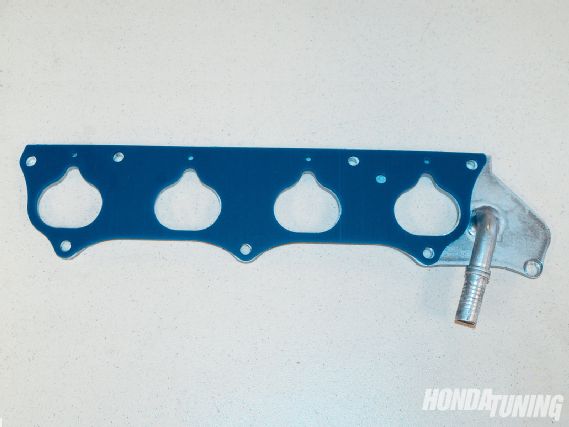 | Hasport's K24A2 intake manifold adapter plate, overlaid with a Hondata RSX-S Heatshield manifold gasket.
| Hasport's K24A2 intake manifold adapter plate, overlaid with a Hondata RSX-S Heatshield manifold gasket. Incidentally the stock intake manifold, which bears the designation RBB in its part number, uses longer, more narrow runners, which MacMillan says is good for torque, while the intake labeled RBC from the European Accord R uses shorter, fatter runners optimized for high-rpm breathing. The RBC intake is a direct-fit replacement for the RBB, which is also found on the 160-hp, 2.4-liter Accord
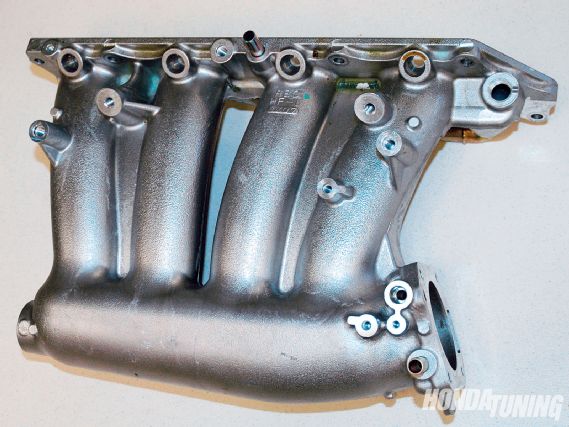 | The Euro Accord R intake manifold.
| The Euro Accord R intake manifold. Camshafts
The K24A2 has large primary (low-lift) lobes on both the intake and exhaust cams. The lobes are larger than those on bumpsticks for both the RSX-S and the Japanese market Integra R K20A and contribute to solid low-end torque. The TSX exhaust camshaft also has larger secondary (high-lift, VTEC) lobes than the RSX-S or ITR, making it a good nominee for a swap into a naturally aspirated K20A2 engine for those interested in just staying with stock Honda parts. The secondary lobes on the intake cam, however, are smaller than the ones on the K20 stick.
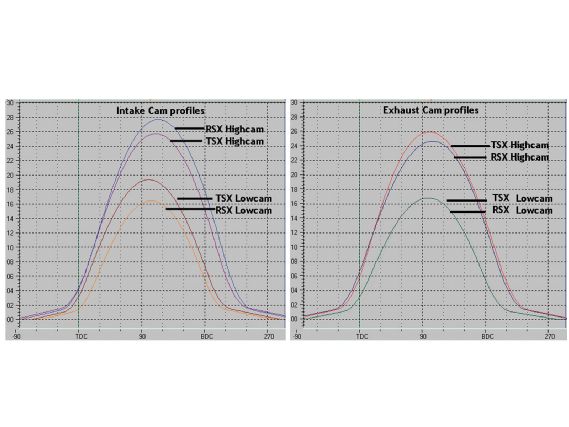 | Acura TSX K24A2 Engine - Playing Catch-up
| Acura TSX K24A2 Engine - Playing Catch-up According to MacMillan, the biggest gift Honda has given to tuners of the K series is the Variable Timing Control mechanism, or VTC. VTC uses a spool valve that directs high-pressure oil to chambers inside the intake cam gear that allows for continuous adjustment of the camshaft's phase, or its position relative to the crankshaft, over a range of 25 degrees advance or retard. In the K20A that range extends to 50 degrees of advance or retard. A separate VTC electronic control unit monitors RPM, camshaft and throttle position, ignition timing and engine exhaust condition to determine the necessary cam phase adjustments.
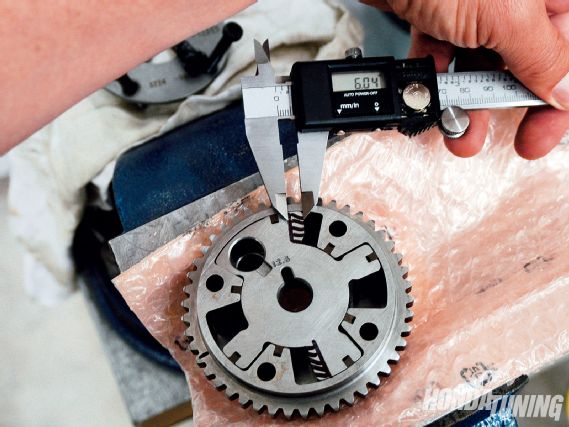 | Metal that needs to be ground from the stock TSX VTC mechanism is measured and marked off.
| Metal that needs to be ground from the stock TSX VTC mechanism is measured and marked off. In every naturally aspirated K20A and K24 motor Hondata has tuned they've found that the intake cam needs to be rotated through 25 to 30 degrees between peak torque and peak power. For a stock TSX engine 25 degrees of cam movement is fine, but completely inadequate for a modified engine with as little as a bolt-on header and intake. MacMillan says a stock engine needs no more than 20 degrees of cam movement on the big lobe; comparatively a well-modified setup needs no less than 25 degrees on the high cam.
To give the TSX engine added VTC adjustability, only one real solution exists, removing extra material from the VTC mechanism. While a person could bolt on an RSX VTC mechanism for the 50 degrees of travel, there is less valve-to-piston clearance on the TSX pistons. Hondata's measurements suggest 45 degrees maximum movement is much safer. Allowing the full 50 degrees of variability may lead to a greater risk of valve to piston contact should there be an accidental over-rev.
For emissions, the ability to rotate the cam to zero at idle to dial out all overlap makes for a very clean engine with no need for an exhaust gas recirculation (EGR) valve. For his testing MacMillan blocked off the EGR porting in the head.
Engine Management
For a while now owners of the K20A, in its various forms, have had a couple of different programmable ECUs to choose from, including Hondata's K-Pro. But when Acura introduced the TSX, the only component the updated computer shared with the RSX was the connector plug. To date Hondata can modify the VTEC point, rev limiter, and fuel, ignition, and cam angle tables for a naturally aspirated TSX. As they believe it will be quite some time before they have the same level of programmability in the TSX ECU as they now have in the RSX, they have adapted the K-Pro for use in the TSX.
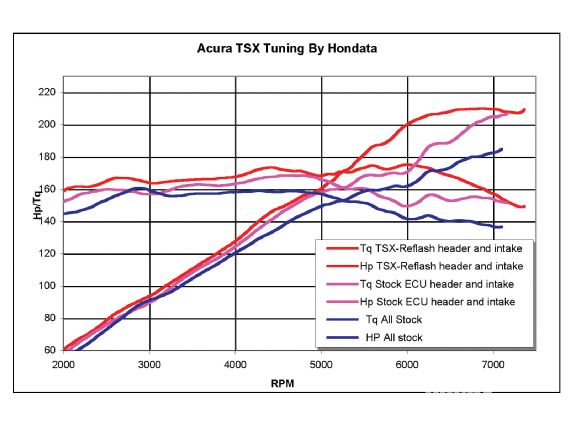 | Results after adding a Comptech Icebox intake and header and re-flashing the ECU. All testing was measured on the Dynapack hub dynamometer at Church Automotive Testing in Wilmington, Calif., a dyno that by most accounts reads six to eight percent higher than a Dynojet.
| Results after adding a Comptech Icebox intake and header and re-flashing the ECU. All testing was measured on the Dynapack hub dynamometer at Church Automotive Testing in Wilmington, Calif., a dyno that by most accounts reads six to eight percent higher than a Dynojet. Connecting the K-Pro involved a custom adapter harness and an Accord throttle body to replace the drive-by-wire throttle. The throttle cable already exists and just needs to be rerouted. A throttle cable holder for the manifold was fabricated, but probably could have been purchased (also from the Accord). Six wires had to be run to read the throttle position and control the idle, functions that are usually automatically handled by the drive by wire.
Using the K-Pro in this way allowed Hondata to rapidly test a combination of components to find what works best for the TSX, but obviously is not suitable for everyday road use. The downside of the conversion is that the instrument cluster, air conditioning, and vehicle stability assist did not work. We anticipate that all of these issues will be ironed out in due time.
First Tests
At about 1,000 miles the stock K24A2 put out 184 hp and 165 lb-ft of torque. After another 2,000 miles MacMillan switched to synthetic oil, added a Comptech header and Icebox intake system, and then re-dynoed. Peak power grew by 20 hp, which MacMillan says is a bit more than is usually seen with header and intake upgrades. He suspects the added running time and synthetic oil probably made the difference.
The next modification was the TSX computer re-flash, where MacMillan dropped the VTEC transition from 6000 rpm to 5000, increased the rev limit to 7600 rpm from 7300, and advanced cam and ignition timing. The adjustments made torque and power in the midrange, with a gain of 25 ponies at 6000 rpm. MacMillan, like many K-series tuners, believes the K24A2 ECU re-flash is the best bang for the buck modification for the TSX. Detailed information on the re-flash is available from www.hondata.com/reflash_tsx.html.
Second Tests
Taking a few pages from the book on tuning the RSX-S, the team at Hondata guessed that the setup tested in the first round probably suffered from too much exhaust backpressure and not enough cam advance. Past research has indicated that with excessive backpressure these motors generally need a higher VTEC crossover point for best results. From previous tuning sessions with the K24 MacMillan also knew that 4000 rpm for a crossover point was possible.
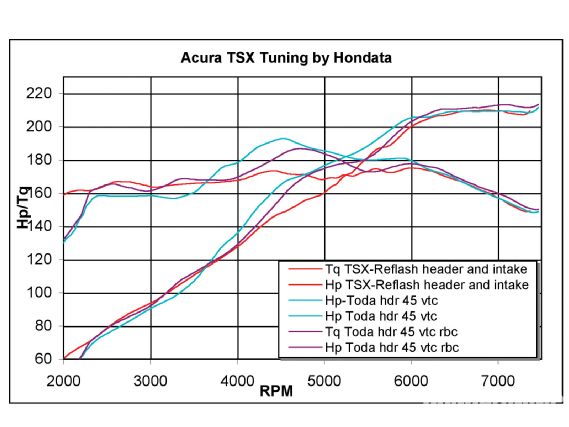 | Results from the second round of tests
| Results from the second round of tests Toda saved the day by providing a prototype header it has designed for the TSX, as well as a test pipe. With the decrease in backpressure and better tuned lengths of the Toda exhaust manifold, Macmillan programmed in more cam advance. Advancing the intake cam allows for pressure waves from the exhaust to travel into the intake. At the right rpm range this reaction can assist the movement of the intake charge into the cylinder.
Air travels into and out of an engine not smoothly, but in pulses. Think of blowing across the mouth of a bottle. Blowing over the opening causes the air in the bottle to vibrate, which results in vibration of the air around the bottle's mouth and makes a sound. An intake creates the same phenomena. For a given diameter and length of tube, there is a resonance frequency. Where this matches the rpm frequency of the engine you will usually find a bump in torque and a lean spot in the air/fuel mix. When MacMillan switched to an Injen cold-air intake, he found the resonance point to be around 4500 to 4700 rpm.
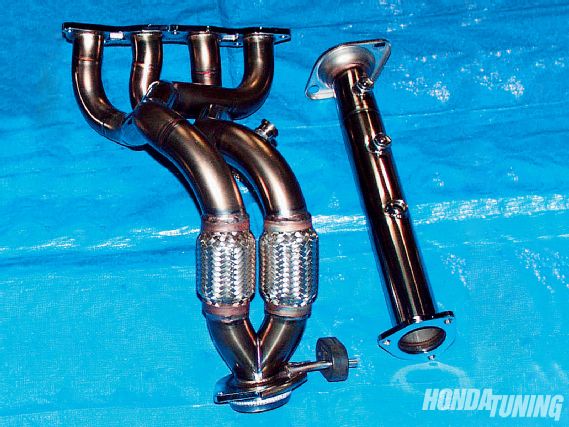 | Toda's header and test pipe for the CL9 TSX chassis
| Toda's header and test pipe for the CL9 TSX chassis At this juncture Hondata switched engine management systems to the K-Pro, using an adapter harness, which they did for a couple of reasons. First, programming the TSX ECU is a time-consuming process and allows for only two dyno runs per hour, too slow to make any real progress in a reasonable timeframe. The other reason for the computer switch is that MacMillan wanted to be able to move the cam past 20 degrees and up to 45 degrees advance, as previously discussed.
Of note on the graph are the lines made after installing the Toda header, Injen intake, giving the engine 45 degrees of VTC, and a K-Pro tune. The VTEC switchover point is a relatively low 3500 and maximum cam angle is 45 degrees at 3500 to 5000 rpm. MacMillan found significant increases in torque throughout the midrange, around 20 lb-ft at 4700 and solid gains all the way up to 6000 rpm. The loss in torque under 3600 is due to repositioning the Injen air intake from outside the car in early testing to its correct position. Back-to-back testing later showed no loss over the re-flash.
MacMillan likes this combination, saying it's well suited to the rev range of the K24A2. The additional torque is accessible in everyday driving, motivating the car without having to visit the top end of the rev range. He believes, however, that there is more midrange torque to be had with a proper race header designed with longer primary and secondary tubes that stretch to the length of the test pipe.
The last tests with this mix of elements involved swapping the RBB intake manifold with an RBC manifold from the Euro Accord R. As explained earlier, this IM has shorter and larger diameter runners than the RBB intake. Hondata found it is well optimized for high-rpm breathing, a gain of two to three horsepower from 6200 to redline, but not enough to offset the loss of torque everywhere under 6000 rpm.
Third Tests
For the third set of pulls, MacMillan installed Toda's N2 camshafts and springs and OE K20A2 valve seats and retainers. After moving the VTEC switch point to 4000 for this setup, gains on the top end were seen from 5400 rpm to redline, increasing to a max improvement of 16 ponies from 7000 on up. There was also a loss in low-end torque, though, due primarily to the N2's smaller primary cam lobes. If your goal is maximum power, however, this appears to be the way to do it.
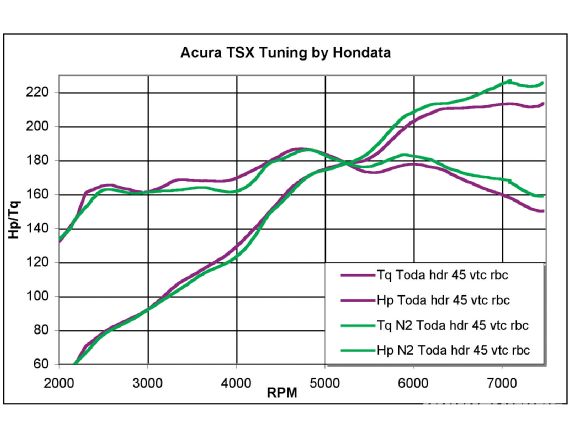 | Results from the third round of tests
| Results from the third round of tests Opening the Throttle Body
The K20 uses a 62mm throttle body to feed a two-liter engine. In comparison, the TSX has a more restrictive 60mm throttle supplying air to a larger 2.4-liter powerplant. This shortcoming in induction prompted MacMillan to explore using a bigger throttle body, and he found two choices. The first is to bore out the existing throttle on the K24, and the second is to replace it altogether with a 64mm throttle body from a TL, a direct fit replacement. Hondata went with the TL throttle body, which they happened to have in stock.
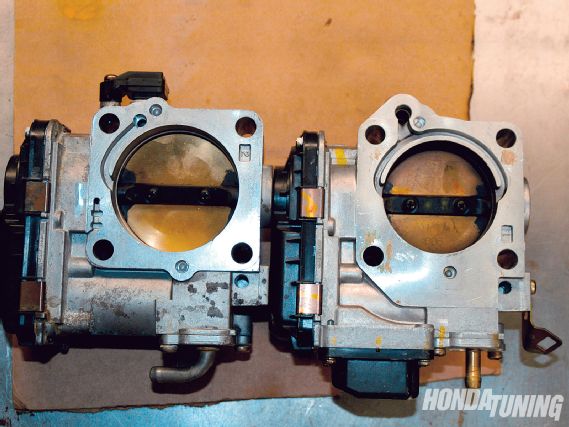 | A side-by-side comparison of the 64mm TL (left) and 60mm TSX throttle bodies
| A side-by-side comparison of the 64mm TL (left) and 60mm TSX throttle bodies To prep the K24 IM for a bigger throttle, MacMillan had to fill in the idle air control bypass, a notch in the opening that is apparently leftover from the manifolds' use on the Accord and no longer needed since idle control is handled by the drive-by-wire. Additionally, on the TL the map sensor mounts directly to the throttle body. This was removed and an adapter added to connect an emissions line.
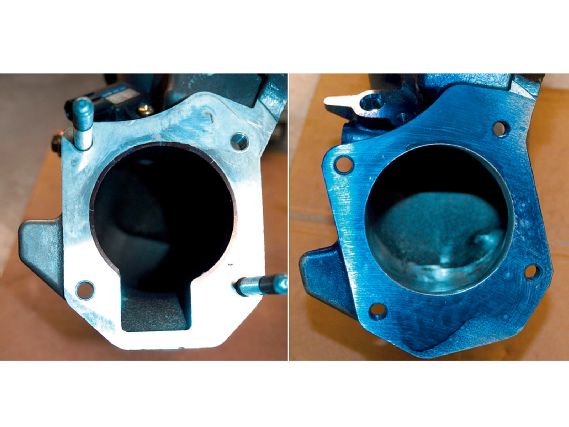 | The stock TSX intake manifold, before (left) and after the opening was ported to 64mm and the idle air control bypass was welded up.
| The stock TSX intake manifold, before (left) and after the opening was ported to 64mm and the idle air control bypass was welded up. For the remaining tests the K24A2 was reequipped with the stock cams and RBB intake manifold. The last pulls reflect about 2 hp from 6000 rpm up, which is pretty close to the margin of error for the dyno. MacMillan speculates a bored throttle body would probably show better gains if tested with the Toda N2 cams and RBC intake manifold, but realistically should be pretty low on the bang-for-the-buck list.
With the current set of modifications, MacMillan decided to go back to a completely stock ECU and see how far he had come. As the curves clearly suggest, the K24 engine has plenty of potential with the right combination of parts, but engine management is the key to extracting that power.
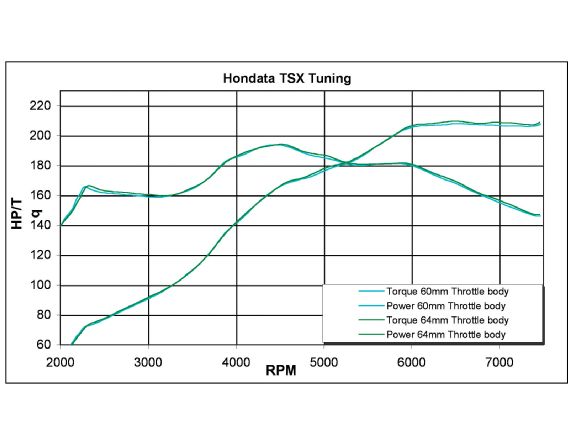 | Results from running a bigger throttle body.
| Results from running a bigger throttle body. From his testing MacMillan determined the TSX engine needs a race header (long tube preferred) for the camshafts to work optimally. Installing aftermarket cams first will actually result in a loss of power. For the emissions minded, a high-flow catalytic converter would be best mounted to the race header about 40cm behind its current position. Finally, a VTC mechanism modified for 45 degrees advance is a must.
Forced Induction and the TSX
The K24 is a long stroke engine. Naturally aspirated, the engine's peak torque is achieved around 6,000 rpm, falling off rapidly on the way to redline. From about 6,500 on up the power curve is fairly flat as a result. At 7,500 rpm the piston speeds are about the same as that of a K20 at 8,500 rpm, while the engine is trying to ingest about 15 percent more air through a head with similar airflow characteristics to a Type-S. This indicates that the naturally aspirated K24 engine is difficult to get high-rpm power from. Forced induction provides an excellent fix for this issue.
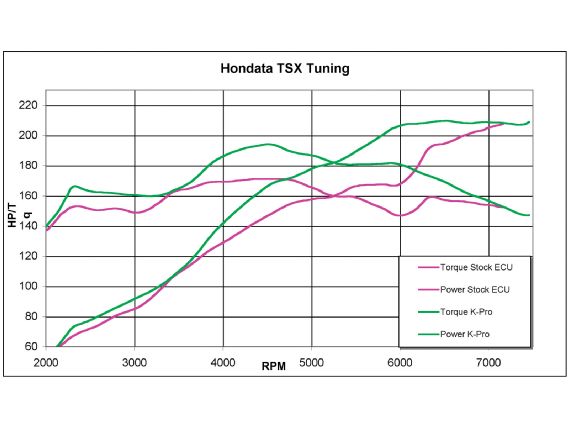 | Stock ECU vs. K-Pro, with Injen intake, Toda header, 45 degrees of VTC, and 64mm
| Stock ECU vs. K-Pro, with Injen intake, Toda header, 45 degrees of VTC, and 64mm Supercharging
Earlier this year Hondata swapped a TSX engine into an EP3 Civic, equipped it with Integra Type R intake and RSX exhaust cams, and a Jackson Racing supercharger. In essence they went bigger on the intake cam and smaller on the exhaust cam. The reason for the bigger intake cam was to allow more compressed air into the cylinder. The smaller exhaust cam was chosen to prevent blow through, a phenomena where supercharged engines with too much exhaust cam can allow the intake charge to blow right out the exhaust during valve overlap.
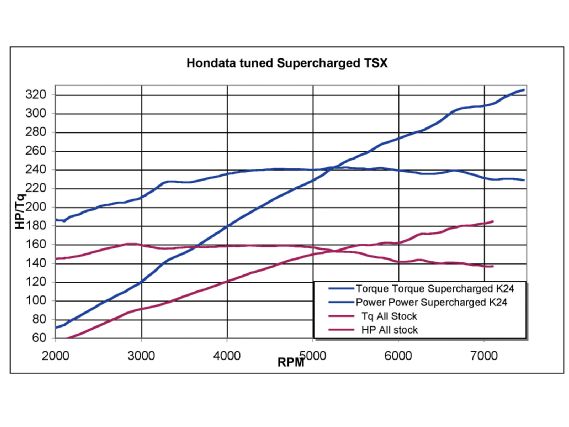 | Acura TSX K24A2 Engine - Playing Catch-up
| Acura TSX K24A2 Engine - Playing Catch-up Boost pressure was around 10 psi at 7000 rpm, and as the chart shows there is no power drop-off at red line and little torque drop as the revs climb. As expected power delivery was smooth and linear. Pictures and more info can be found at http://www.mrrocket.com/ep3.htm.
Turbocharging
As of press time, only a few hearty souls that we've heard of have opted to turbo a TSX engine. Hasport, masters of shoehorning big motors into small Hondas, has one such engine installed in an '01 Civic. The tuning was not complete, but MacMillan was still able to glean some useful data.
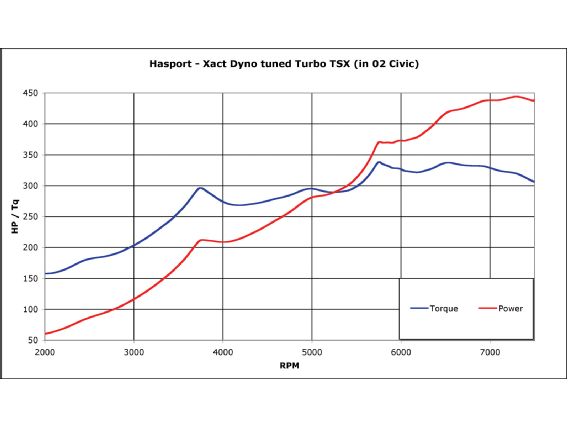 | Acura TSX K24A2 Engine - Playing Catch-up
| Acura TSX K24A2 Engine - Playing Catch-up The K24 was outfitted with a Full Race turbo manifold, T3/04e turbo with 51-trim, 3-inch exhaust, and an exhaust camshaft from an RSX-S. Pistons, rods, and the rest of the engine were left basically stock, as the boost was wound up to 12 psi. Tim Kelly from Xact Dyno performed the tuning.
Keep in mind that this final graph reflects an unfinished tune and is in no way representative of what the engine can really do with a turbo. MacMillan strongly warns not to try this on an unprepared engine; this is far too much torque for the stock components to take. At this boost and power level, stronger pistons and rods are an absolute necessity. He wanted us to show you the results anyway, though, as the power figures are pretty impressive, almost 450 hp at the top of the powerband.

